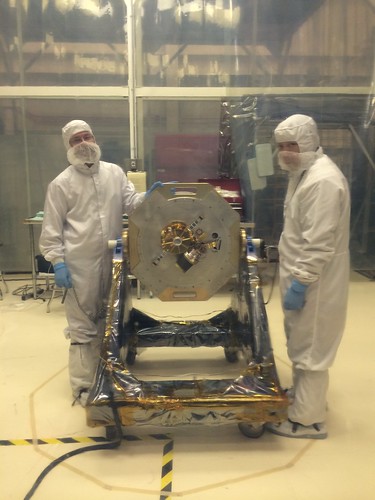X-ray Detectors on the Move
- By Maggie Masetti
- May 1, 2014
- Comments Off on X-ray Detectors on the Move
Here at NASA Goddard, in Astrophysics, we have quite a large group that studies high-energy light – that is, X-rays and gamma-rays. Not only do our astrophysicists study the objects that emit light at these energies, some of them build the instruments to collect this astronomical data.
One such astrophysicist is Dr. Rich Kelley. [Fun fact – he plays lead guitar in the Blueshift podcast theme song, which is primarily his composition.] His latest project is a Soft X-ray Spectrometer (SXS) on the joint US/Japanese satellite Astro-H, which is due to launch in 2015. Astro-H will explore the extreme universe that is abundant with high energy phenomena around black holes and supernova explosions, and observe clusters of galaxies filled with high-temperature plasma.

Illustration: Akihiro Ikeshita / JAXA
The SXS is a system of X-ray calorimeters that sit behind an X-ray telescope. A calorimeter works by detecting tiny temperature changes. When an incoming X-ray is absorbed in the detector, the detector heats up a tiny, tiny amount. In order to detect such a small temperature difference, the detector must be very cold – it will run at 50 milli-Kelvins, or 50 thousandths of a degree above absolute zero. You can read more about how X-ray calorimeters work on the Collaboration website for Astro-H.
The SXS just recently passed a big milestone when its detectors were shipped to Japan for integration and testing.
I got the chance to see them, literally right before they put the shipping cover on. Rich gave me a little tour and I was able to snap this picture through the clean tent:

Credit: Maggie Masetti
Rich gave us a few close-up images of the hardware, which Kevin Boyce, systems engineer and sometime Blueshift blogger, captioned for us. [Second fun fact: Kevin plays bass on the Blueshift podcast theme song. Ok, full disclosure – Rich, Kevin and I play in a band together.]

Credit: NASA
Above you see the Detector Assembly (DA) and 3rd stage of the Adiabatic Demagnetization Refrigerator (ADR) that keeps the detectors at 50 milli-Kelvins. The detectors are just behind the center of the circular plate labeled Detector Assembly. The ADR has three stages, of which this is the warmest, running between 1.5 and 4.5 Kelvins. The other two stages are on the other side of the mounting plate, and can be seen in the photo below. An ADR consists of a superconducting magnet, a slug of ferromagnetic salt (the “salt pill”), and one or more heat switches. The magnet and salt pill are inside the area marked as “ADR”.

Credit: NASA
Above is the bottom of their subsystem. Here you can see the magnets for Stage 1 and Stage 2 of the ADR. Actually what you see is magnetic shielding. It is important to keep the very high magnetic fields contained within our instrument, so as not to confuse the geomagnetic sensor (essentially a compass) on the spacecraft. Therefore we have this shielding. The suspension systems are also marked. Each of these is a set of Kevlar strings that support the salt pill within the magnet. This is used to thermally isolate the salt pill from the much hotter surroundings. For instance, in Stage 1 the salt pill runs at 50 mK, while the surroundings are about 1.2 K (24 times hotter; that’s a bigger ratio than between our body temperature and the surface of the sun).

Credit: NASA
Above is other view of the DA and ADR 3rd stage. The detector output wires are marked. All other wires you see are either current supply to the superconducting magnets or thermometer wires. There are 44 thermometers in the system, so we can measure temperature in many different places. Also visible in this photo is a temporary protective cap, made of a small aluminum parts tray and tape, to protect the X-ray filter from damage. The filters allow X-rays through, but not visible light, ultraviolet, infrared, or radio waves. They are very delicate; you can break them by breathing on them.
We’ll keep you updated on this cool (literally!) mission – we wish them the best!


